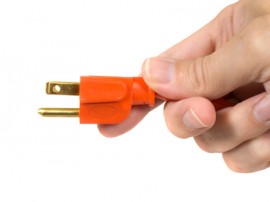
PORTABLE GENERATORS
The use of portable generators is a common piece of equipment used on filming sets, special events, commercial/industrial, emergency response and or disaster relief, and other locations where shore power is not readily available.
Because most remote locations do not have sufficient power supplies to operate lighting and electrical equipment, portable generators are used either as a primary source of power or in some cases, for supplemental use. When a portable generator is used on location, there must be a qualified operator to oversee its use. This should be a qualified trained electrician. The following items should be inspected and discussed with the operator to assure the following safety guidelines are being met.
- Ensure there is at least a 5 lb. 40 B.C. multi-purpose fire extinguisher or equivalent available.
- Inspect the generator compartment for leaky fuel hoses or oil soaked insulation.
- Ensure the generator is not parked beneath a combustible fuel source (e.g. leaves, dry vegetation, sprinkler heads, overhanging tree branches,) or blocking fire protection systems such as fire hydrants, standpipes, fire dept. connections, access ways or exits.
- Production companies require that all generators are fueled to capacity prior to arriving on location, this prevents productioninterruptions. If a generator is required to be refueled, the generator operator shall shut down the power prior to refueling and assure that a ‘no smoking” policy is implemented.
- On most generators, exhaust and intake ventilation doors automatically open when the generator is started. Ensure that the generator operator has opened the ventilation doors on those generators that require manual operation.
- Insure that tractor mounted or the trailer-mounted generator is properly secured and stationary. Emergency breaks and/or wheel chalks should be placed on the wheels to prevent movement.
- Inspect for obvious electrical hazards such as: proper grounding of the generator per requirements of equipment, frayed electrical cables, proper cable connection to the power output bus, protected from unauthorized personnel.
Obvious electrical hazards can be remedied by the fire safety officer, however more serious electrical hazards should be immediately corrected by onsite electrical personnel or electrical inspector.
GROUNDING / BONDING
Bonding and grounding are separate requirements for generators and other electrical distribution systems. Grounding means the connection, or the establishment of a connection, of an electric circuit or equipment to reference ground, which includes the generator’s frame. Bonding is the intentional connection between the grounded circuit conductor (neutral) and the grounding means for the generator, which includes the generator’s frame. Thus, effective bonding of the neutral conductor to the generator’s frame is also a concern for the safe use of the equipment. As with grounding terminal connections, proper bonding of the neutral terminal of a power receptacle may be confirmed via testing by a competent electrician with the correct equipment, and the ohmic resistance should measure near zero and must not be intermittent, which indicates a loose connection.
U.S. Department of Labor
www.osha.gov
(800) 321-OSHA
For more complete information:
WEBSITE NOTES POSTINGS ON GROUNDING
“Grounding electrodes are only required if the generator is a separately derived system. Ground rods (grounding electrodes) are only required if the generator is a separately derived system. The key to knowing if a generator is a “Separately Derived System” is not the generator, but rather if the generator is being connected to a building and or building transfer switch. If the buildings transfer switch does not transfer the neutral (grounded conductor), then the generator has a “solidly connected” grounded circuit conductor and the generator is not a separately derived system. “
“In the 2011 NEC, Article 250.4 (A)(5) states, in part, “The earth shall not be considered as an effective ground-fault current path. So even if you ground the generator, by Code, an electrode in the ground may not provide the protection you seek.”
“A generator that has no reference to earth ground, as is the case if neither side of the winding is connected to earth, will not produce any voltage relative to earth ground on EITHER terminal. It is isolated and the effect is the same as grabbing the hot terminal of a battery; nothing happens.”
“Because grounding one conductor of a generator causes the ungrounded conductor to have a potential relative to ground, it actually increases the hazard that can exist if one comes into contact with the ungrounded conductor.”
“A GFCI breaker does not rely on the existence of a ground. A GFCI measures the difference between the hot and the neutral currents and trips if they are not the same. There are many installations where GFCIs are installed BECAUSE no ground is available.”
“In most cases a ground rod has too much resistance to trip a breaker even if there is a ground fault. The resistance would have to be 8 Ohms or less to trip.”
“NEC 250.4 General Requirements for Grounding and Bonding. The following general requirements identify what grounding and bonding of electrical systems are required to accomplish. The prescriptive methods contained in Article 250 shall be followed to comply with the performance requirements of this section. (A) Grounded Systems. (1) Electrical System Grounding. Electrical systems that are grounded shall be connected to earth in a manner that will limit the voltage imposed by lightning, line surges, or unintentional contact with higher-voltage lines and that will stabilize the voltage to earth during normal operation. The (grounding electrode) rod in this case will do nothing unless the generator is struck by lightning”.
PLEASE NOTE:
Generators Unlimited will supply a grounding rod and required grounding cables and clamps upon customer request. The 8’ Copper Glad grounding rod is a purchased item, as they most often are un-retrievable without being damaged. Generators Unlimited staff will not install grounding rods into the earth. When onsite digging is required, it is best that the customer “call before digging” to prevent property damage, while limiting the risk associated with the realistic possibility of digging into underground gas-lines, water pipes and electrical conduit. In addition, in some jurisdictions it is “illegal to dig or drive a ground rod in the ground unless you first call the local utilities and request a survey of the area”.
Please contact us should you require additional information.


One thought on “Portable Generators and Grounding”